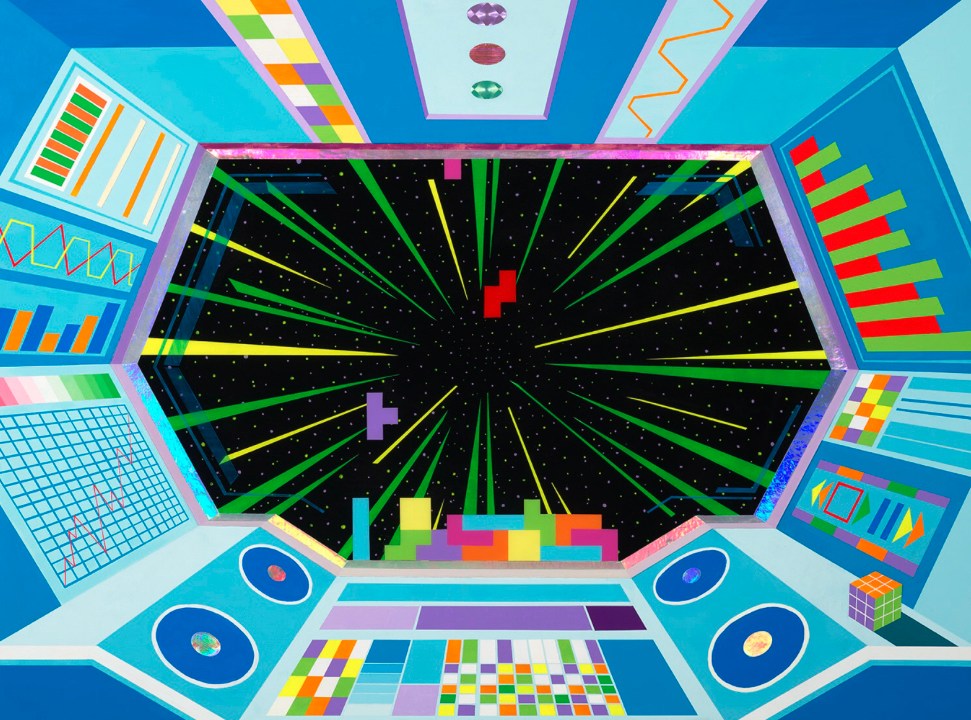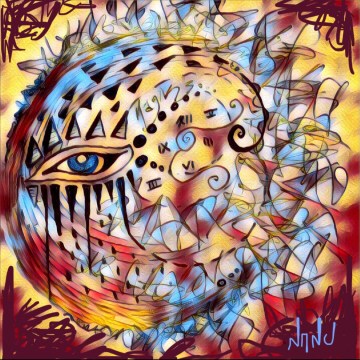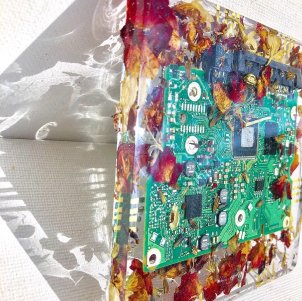
Every year I feature an emerging technology in TrendsWatch, and this year I dove into blockchain—the distributed, encrypted digital ledger system that supports both cryptocurrencies like Bitcoin and Ether, and “crypto-art” like Primavera De Felippi’s Plantoids. However, after polling some museum folks on their familiarity with blockchain, I realized I had to devote most of the chapter to explaining the basics of what this technology is, leaving little room to expand on what it does or could do for people working in, with, and around the museum sector. In today’s post, I invite Nanu Berks and RFX1 to share some thoughts on blockchain from their perspective as artists.
–Elizabeth Merritt, VP Strategic Foresight & Founding Director, Center for the Future of Museums
Nanu and RFX1, pretend you’ve gone out for happy hour with a bunch of the Blog’s readers—please introduce yourself as we order the first round:
Nanu: Buenas! My name is Nanu, I am an Argentinian artist focused on designing immersive experiences that explore the intersections between consciousness expansion and planet-positive technologies.
From murals in public places, to fine art, clothing, and 5-senses experiments, we explore together what it means to heal trauma for ourselves, for our communities, and how innovative technologies can help us allocate resources in ways that benefit the collective.
RFX1: Hello, I am RFX1, a visual artist from Los Angeles that specializes in retro-futuristic murals and paintings that incorporate the spiritual and psychological elements of the human experience.
How does blockchain influence your work, either as a topic or as a tool?
Nanu: My family lost all of its life’s savings, jobs, and possessions to the crisis of ‘08 when banks in Argentina closed overnight and the people’s savings disappeared. I left home early on and became a nomadic artist who lived in a trade economic system painting murals and teaching healing art classes in exchange for wonderful apartments, travel, and food for over a decade, obsessed with re-defining value.

The dollar-to-hour or dollar-to-dollar economy made little sense to me as a digital nomad and an artist. The fact that one economy or brand can control so many resources regardless of how this impacts the planet or people is an outdated format we are moving away from. To me the blockchain is a 3-D print of our consciousness, a next level internet, a new tool without borders that fosters super-collaboration, decentralization, and in some ways supports many of the nomadic values that I find sustainable and that give me hope. The overlap between tech and nature feels seamless, computer circuits are like mycelium, the first airplanes were modeled after flying insects, the fact that I now use some blockchain symbology to drive the messages of compassion and decentralization through my work is just a natural progression of our history, just how hieroglyphics were depicted in the past, and how sacred geometry imagery is coming back. We make art to store our memories and design who we become.
RFX1: Blockchain has begun to influence my work visually as I incorporate charts and graphs into a sci-fi setting. This was inspired from looking at those cryptocurrency charts all day and night at one point. Also, my work always involved cubes in some way, and the blocks in blockchain just happened to fit!
One of the murals I worked on last year was about how the future is bright through blockchain technology. It has also been used as a tool, as this mural has been uploaded and secured to the blockchain thanks to Blockchain Art Collective. Now people can scan a chip and look up my information as they walk by the mural.
You’re on an elevator with a Very Important Someone, and have 15 seconds to convince zim that blockchain is very important to the future of art. Go.
Nanu: The value of an art piece grows exponentially based on provenance, beyond the technique and the artists themselves, however only a few people benefit from this amplified gain, usually not the artist. Blockchain provides several secure systems to track and give proof of originality to a work of art, automatically raising its worth and fairly compensating everyone involved in the transactions along the history of the traded works.
In a world where personal branding, micro-influencers, and decentralization are shifting the market’s demands, this solution becomes imperative.
Art is also highly valued depending on its time in history, I believe art created during the first few decades of the blockchain evolution will become a great part of our history.
RFX1: Blockchain is important to the future of art since it can authenticate works on a digital ledger. It can also help artists to protect their work and monetize their digital assets through monetization. Many companies are selling our information and digital assets while we make nothing and are being exploited by them. Now, blockchain can allow for people to have ownership of their online presence and assets through various networks that specialize in this field of tokenizing one’s digital assets, such as reproductions of an artwork.
How do you see blockchain affecting the economics of being an artist, now or in the future?
Nanu: Blockchain is very early in its development, essentially still in pre-mass-adoption phase. This is why it is still tough for some people to see the full extent of blockchain’s potential. However the little initiatives we are seeing now, for example quickly adding a tech layer like an NFC (near field communication chip) to a physical piece of work, or creating an NFT (non-fungible token) or a smart contract for a “rare” or limited digital print run collectible, is already hinting at what this technology can do for artists.
At a very basic but important level, the use of blockchain could reduce unauthorized replication of music, visual art, any kind of art. Early on during the dot-com rush, we could establish the authenticity of a book or piece of art by the original date the owner published it on the web. That system is not very secure, and it is easy to manipulate or edit. If we can leverage some of these same ideas in a decentralized (data stored across many different points) ledger that is immutable (securely encoded to prevent unauthorized changes to the whole ecosystem), then the initial records cannot be changed, and so proof of originality is much more viable.
For a more tangible example, imagine painting a mural, spray painting your QR code or your public wallet address next to it, and coming home to find you have received $300 from over 100 people who walked by your mural and—in addition to taking a selfie and tagging you on social media—donated some tokens, or cryptocurrency for your work. Of course, this begs a larger conversation about funding for public art projects, museum residencies, and so on. We have been surrounding this topic of “decentralization” even since before blockchain showed up. GoFundMe and Patreon, along with microloans and any other version of decentralized fundraising, are a part of this blockchain evolution; the only difference is that now we have secure encryption to go along with it.
I could write about this forever, but here are a few other examples: artists learning how to fairly negotiate for what they are worth by having records of their art and social value, art collectives fairly distributing opportunities to their artists, the opportunity to create art for a niche group of people that have wealth to invest (let’s continue to advocate for it to be invested in creativity and education for compassionate creative solutions!). The list is really endless. Frankly I was very resistant to technology at first (more about this on my blogs at www.nanuberks.com). However, I’ve concluded that tech is a natural expansion of our consciousness. We can either use these tools or ignore them, but they are not going away.
RFX1: I think blockchain can positively affect being an artist, as more platforms begin to emerge from the technology. There are many companies like Blockchain Art Collective working to support artists, by trying to solve a problem of authentication and providing data about the artist to the consumer. There are also other platforms in development that are like online marketplaces for art with added security and authentication, creating a safer online environment for artists to thrive.
Creating a secure record of the provenance of works also benefits collectors and investors of art. A transparent digital ledger can show when the art was created and authenticated, and, if it was sold, when and for how much. This can show a whole new side of art buying that allows people to safely buy authenticated artworks. Also, people are beginning to be more interested in digital collectibles, and the added authentication adds the reliability and security that they are buying a true digital asset.
Artists being able to tokenize their work on the blockchain will greatly benefit the art economy. Right now, many artists are creating free content for social media to boost their following. In the near future, artists will be able to “tokenize” their digital and physical assets via the blockchain. This will enable artists to get paid for the content they are putting out via social media. Fans can basically tip artists with tokens. I think that in the future, when most jobs have been taken over by automation, most people will be making money in the form of cryptocurrency through their various social media channels.
Are there any blockchain art projects you particularly admire, that you recommend our readers check out?
Nanu: Absolutely the Blockchain Art Collective, where RFX1 and I have featured some of our work. They are impeccable humans full of integrity and the right intention to help artists monetize and track their work as it evolves. They are one of the few teams working towards connecting physical artworks to the blockchain rather than just digital renderings, and out of all the systems I have tried, the absolute best.
I also recommend Pixeos.io, whose motto is “Where Games and Art Collide.”
They are doing an amazing job of bringing joy and playfulness back into the process of creation, and their community is very welcoming and engaging for artists at all levels in all mediums. The Pixeos team is really wonderful as well, made up of artists from all over the world, and they prioritize creative freedom, and the healing possibilities for art as expression, over art as a finished product. They have a big community on the Telegram app, if you would like to connect with them, and on Twitter they are @eos_pix.
RFX1: I agree with Nanu about the Blockchain Art Collective. I have heard of other blockchain art projects that are in development. Since BAC is already up and running, I would recommend people check them out! They provide NFC chips that artists can put on their works, even on murals (as I have done) to connect work to their network! People can then scan this chip and they will be provided with all the information on that artist and the work.
And finally—Nanu, please ask RFX1 a question, and RFX1, you lob one at Nanu.
Nanu: RFX1 I see your work reflects some futurism, and in a way tech through parallels of synchronicity. I also relate to the idea of nature and tech as parallels, however I wonder, were you interested in using technology layers in your physical artwork before finding the Blockchain Art Collective? Do you see yourself integrating more tech into your art? If so what types of technology?
RFX1: I have always been interested in the future since I was young, and I’ve always had a love/hate relationship with technology. The incorporation of technology into my work is a representation of society’s addiction to technology, including social media and cryptocurrencies. But the themes of the universe have always been a part of my work, and my work is about pushing humanity forward through technology after creating this huge mess in the first place. The only way forward is by finding new solutions to fix the problem. I do see myself incorporating other forms of technology into my work, such as AR and VR. I definitely want to work with other creatives to make an experiential show that utilizes both old and the new technologies.
Now it’s my turn to ask a question. Nanu, looking at your works, I understand your need for expanding consciousness and planet positivity. How do you think blockchain will benefit human consciousness and planet positivity, given that cryptocurrencies like Bitcoin use up so much energy and resources? How do you think blockchain will benefit society in this way? How will it expand consciousness?

Nanu: Great question! And I relate to your love-hate relationship with tech. At one point I thought I would live in the jungle off-grid forever for some of these exact reasons, seeing humanity abuse nature by exploiting its resources. The massive energy consumption required to maintain blockchain is certainly a topic that many people bring up. This is why I prefer currencies that “mine” (generate cryptocurrency) using green energy. I think we have to switch to green energy for everything we do, whether it’s Bitcoin mining, or driving, or anything else. I am most interested in a different kind of mining—basically monetizing our own content and data that we create, (which still requires internet, however not mega computers.) Check out the “own your data movement” and how humans could cover their basic living needs without working just by re-claiming their data and getting paid their share from huge conglomerate gatekeepers.
Thank you so much, Nanu and RFX1! How can readers follow your work?
Nanu: you can follow me on my blog, on Twitter @NanuBerks, on Instagram @nanu_berks, and at the Blockchain Art Collective.








